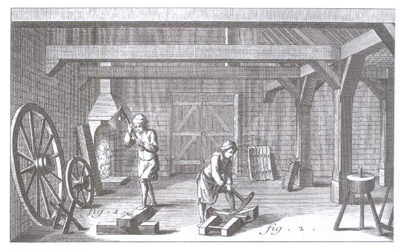
The illustration above is by Diderot.
A wheelwright (or wainwright) is a person who builds or repairs wheels. The word is the combination of "wheel" and the archaic word "wright", which comes from the Old English word "wryhta", meaning a worker or maker.[1] This occupational name eventually became the English surname Wheelwright.
Historically, these tradesmen made wheels for carts and wagons by first constructing the hub, the spokes and the rim/fellows segments and assembling them all into a unit working from the center of the wheel outwards. Most wheels were made from wood but other materials have been used, such as bone and horn, for decorative or other purposes. Around the middle of the 19th century iron strakes were replaced by a solid iron tire custom made by a blacksmith who first measured each wheel to ensure proper fit. Strakes were lengths of iron that were nailed to the outside of wheels to hold wooden wheels together. Strakes were replaced around the mid-1800s by more dependable iron tires that were fastened to the wooden wheel by both the tight fit of the tire/band as well as tire-bolts. Tire-bolts were less likely than tire-nails to break off because they were flush with the wheel's outer surface. During the second half of the 19th century the use of pre-manufactured iron hubs, and other factory-made wood, iron and rubber wheel parts became increasingly common.
Definition from wikipedia.
http://en.wikipedia.org/wiki/Wheelwright
For additional information on Wheelwrights please see: Firth Haring Fabend, "Cosyn Gerritsen van Putten: New Amsterdam's Wheelwright," de Halve Maen, 80 (Summer 2007), 2:23-30.

